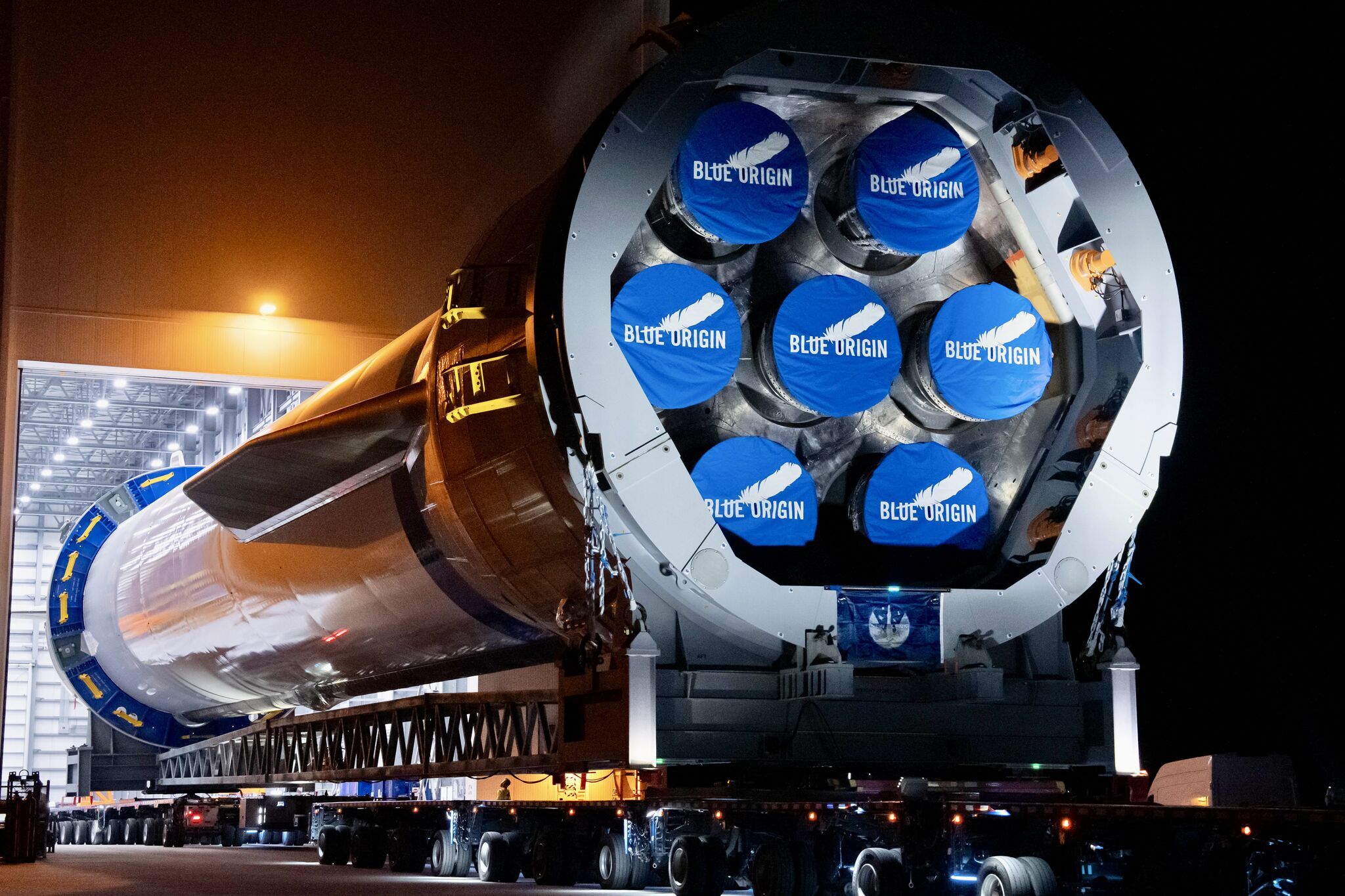1.11.2024

Blue Origin's New Glenn rocket rolls out of its hangar on Tuesday night. Credit: Blue Origin
Blue Origin took another significant step toward the launch of its large New Glenn rocket on Tuesday night by rolling the first stage of the vehicle to a launch site at Cape Canaveral, Florida.
Although the company's rocket factory in Florida is only a few miles from Launch Complex 36 at Cape Canaveral Space Force Station, because of the rocket and transporter's size, the procession had to follow a more circuitous route. In a post on LinkedIn, Blue Origin's chief executive, Dave Limp, said the route taken by the rocket to the pad is 23 miles long.
Limp also provided some details on GERT, the company's nickname for the "Giant Enormous Rocket Truck" devised to transport the massive New Glenn first stage.
"Our transporter comprises two trailers connected by cradles and a strongback assembly designed in-house," Limp said. "There are 22 axles and 176 tires on this transport vehicle. It’s towed by an Oshkosh M1070, a repurposed US Army tank transporter, with 505 horsepower and 1,825 pound-feet of torque."
The transporter can only take certain roads due to its length, 310 feet (95 meters), and height with the rocket on board. The New Glenn booster has a diameter of 23 feet (7 meters), which is far too large to transport beneath conventional bridges.
A big step
Moving the rocket to the launch site is a key sign that the first stage is almost ready for its much-anticipated debut. Development of the New Glenn rocket would bring a third commercial heavy-lift rocket into the US market, after SpaceX's Falcon Heavy and Starship vehicles. It would send another clear signal that the future of rocketry in the United States is commercially driven rather than government-led. Critically, New Glenn is also designed to have a fully reusable first stage, which will attempt a droneship landing on its first flight.
The rocket must still undergo two key milestones, completing a wet dress rehearsal in which the vehicle will be fully fueled and its ground systems tested. This will be followed by a hot-fire test during which the first stage's seven BE-4 rocket engines will be ignited for several seconds.
A little more than a month ago, Blue Origin ignited the second stage of New Glenn for 15 seconds. The upper stage's two BE-3U engines, fueled by liquid oxygen and hydrogen and each producing 173,000 pounds of thrust, burned nominally, according to the company.
These are the pivotal final steps before launch, but this is also a period when problems can be found. For example, this will be the first time the flight versions of the first and second stage will be mated and integrated, and then connected to the ground systems at Cape Canaveral. As the size of the transporter suggests, these are large and complex machines. Inevitably, there will be challenges in the coming weeks.
Can they make orbit this year?
Blue Origin founder Jeff Bezos has been pushing the company hard to launch New Glenn for the first time this year, and the schedule is getting tight. Blue Origin already had to stand down from an October launch attempt and delay the launch of a small Mars-bound payload for NASA called ESCAPADE.
So how long will New Glenn sit at the pad before launching? Consider the example of SpaceX and its Falcon Heavy rocket, also a heavy-lift vehicle. SpaceX moved that rocket to the launch pad for the first time on December 28, 2017, and hot-fired the vehicle on January 24 of the following year. The liftoff of the first Falcon Heavy rocket occurred on February 6. All of this work comprised 40 days.
This is far from a perfect comparison, as the Falcon Heavy—comprising three Falcon 9 cores—was a more complex vehicle in terms of integrating the three large rockets into a coherent first stage. However, by that time, SpaceX had launched nearly 50 Falcon 9 rockets, so they had much more operational experience than Blue Origin, with its debut orbital system. SpaceX is also known for working quickly. Thus, a reasonable no-earlier-than date for New Glenn's debut is likely early to mid-December.
Quelle: arsTechnica
